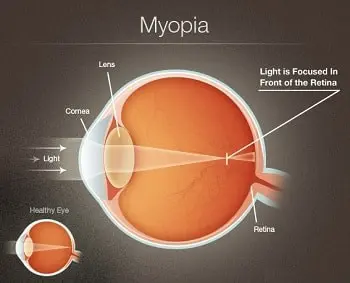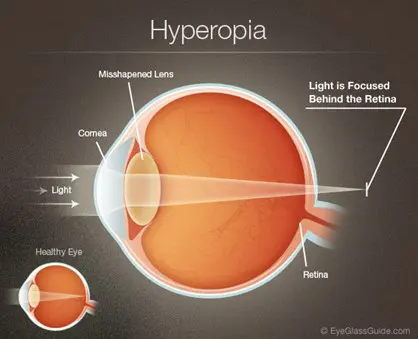Contents
Nearsightedness and Farsightedness: Everything You Need To Know
Both nearsightedness and farsightedness are eye related syndromes that take place from early childhood. It can restrict the person’s ability to achieve clear view of far away and nearby objects.
What Is Nearsightedness or Myopia?

Is it difficult to visualize distant objects, such as road signs, till you’re several feet away, but easy to scan a close image? This means that you’re myopic, conjointly called nearsightedness. It’s a fairly common condition that your ophthalmologist will fix with either eyeglasses, contacts, or eye surgery.
Causes of Myopia
In myopic eyes, the pictures focus before the tissue layer, rather than directly on the tissue layer whereas, in normal eyes, pictures are formed on the retina. Therefore, this causes blurred vision. Doctors call this a refractive error.
High Myopia: It is a severe level of nearsightedness and it may raise your likelihood of getting different eye conditions such as a vision defect, cataracts, and eye disease.
Degenerative Nearsightedness: Conjointly referred to as pathological or malignant myopia, it’s a rare kind, you always inherit from your folks. Your eyeball gets longer terribly quickly and causes severe nearsightedness, sometimes by the teen or early adult years. This kind of nearsightedness will worsen so much into adulthood. Besides having difficulty visualizing things at a distance, you’ll have a better likelihood of getting a vision defect, abnormal growth within the eye (choroid neovascularization), and eye disease.
Symptoms of Myopia
- Headaches
- Squinting
- Eyestrain
- Eye fatigue after you attempt to see objects quite some feet away
Diagnosis And Treatment
An eye test will show you if you’re myopic or not. Glasses, contacts, or refractive surgery will sometimes correct the matter. When you have nearsightedness, your prescription for glasses or contact lenses is going to be a negative variance. The more negative the number is, the stronger your lenses are going to be. As an example, -3.00 is stronger than -2.50. Your prescription helps the attention, focus, lightweight on your tissue layer. That clears up your vision. Eye surgery will improve your vision to an extent that you will not need to wear glasses or contacts. The foremost common procedures for nearsightedness include:
Photorefractive Keratectomy: Commonly referred to as PRK, this surgery uses an optical maser to sculpt the centre layer of your tissue, which flattens the cornea’s curve and allows light-weight rays to focus nearer to or on your tissue layer.
LASIK: Lasik is the most common surgery for nearsightedness. The doctor uses an optical maser or another tool to make a skinny flap on the highest layer of your tissue layer. He sculpts the tissue layer with another optical maser and moves the flap into place.
In the case of severe nearsightedness, special contacts or mydriatic eye drops are found to be effective in slowing the progression. In some cases, your doctor could suggest cataracts or clear lens replacement surgery.
What Is Farsightedness or Hyperopia?

Hyperopia or farsightedness is a condition when you are unable to see things that are nearby. Your eyes focus more on distant objects than on near ones.
Causes of Hyperopia
Your eyes specialize in lightweight rays and send the image of what you’re observing to your brain. Once you’re farsighted, the sunshine rays don’t focus in the manner they ought to.
The image which is supposed to be formed on the retina is formed outside it. Therefore, the image is not created inside your eyes and hence we are not able to see anything. If your eye is simply too short, or the facility to focus is simply too weak, the image can attend the incorrect place, behind your tissue layer. That’s what makes things look bleary.
Symptoms of Hyperopia
You may have:
- The trouble that specializes in near objects
- Headaches
- Blurry vision
- Eyestrain
- Fatigue or headache when you are doing a close-up task like reading
If you have got these symptoms after you wear glasses or contacts, make sure you consult your doctor. As they will then guide you about the major reasons behind its origin.
Diagnosis For Hyperopia
All it takes to diagnose farsightedness could be a basic eye test. Your doctor can have you read a chart placed at a distance. It helps the doctors to examine your eyes and identify the presence of farsightedness, they may also use a tool referred to as a retinoscope to examine the reflection of light entering your eyes on your tissue layer. They’ll conjointly use a phoropter – a testing device — to assist them to opt for the most effective prescription for glasses or contacts.
Treatment For Hyperopia
For clear vision, you would possibly need:
- Glasses
- Contact lenses
- Vision correction surgery like LASIK
With farsightedness, your prescription could be a positive variety, such as +3.00. The upper the quantity, the stronger the lenses. Talk to your ophthalmologist regarding your choices, and all the necessary details regarding it.
Hyperopia Complications
Adults don’t sometimes have complications from farsightedness. Some kids could have issues such as:
- Lazy eye (amblyopia)
- Eyes that aren’t aligned (strabismus)
- Delays in development
- Learning issues
Ordinary vision is achieved when light is centred straight around the retina instead of in front or behind it. An individual with ordinary vision can see objects unmistakably close and far away. Myopia brings about obscured vision when the visual picture is engaged before the retina, as opposed to straightforwardly on it. It happens when the physical length of the eye is more prominent than the optical length. A myopic individual sees close objects clearly, while far away objects become blurry.
Farsightedness is the consequence of the visual picture being engaged behind the retina instead of straightforwardly in it. It might be brought about by the eyeball because of it being excessively little or the centering power being excessively feeble. Farsightedness is frequently present from birth; however, youngsters can regularly endure moderate sums without trouble and most grow out of the condition.
If you are having any problem regarding your vision visit our hospital in Delhi. You may also check our website eyemantra.in Call 9711115191 or mail us at [email protected] to book your appointment with us.



